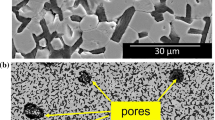Abstract
A WC-Co coating was sprayed by the high-velocity oxyfuel process using a feedstock of tungsten carbide clad with cobalt. The structure of the sprayed coating was characterized by x-ray diffraction (XRD), differential scanning calorimetry (DSC), and differential thermal analysis (DTA). It was found that an amorphous phase of Co-W-C ternary alloy observed as a large, broad peak in the XRD pattern can be formed in the as-sprayed WC-Co coating. The DSC, DTA, and XRD analyses revealed that the amorphous phase crystallized at a temperature of around 873 K to metallic cobalt, Co6W6C, and tungsten with appreciable precipitation of free carbon. The heat treatment of as-sprayed WC-Co coating at a high temperature of 1173 K suggests that annealing at a temperature higher than about 1104 K will promote the reaction of tungsten and cobalt with carbon to form the complex carbide C06W6C.
Similar content being viewed by others
References
W. Wilewski, Some Phenomena Occurring during Plasma Spraying of WC-Co Composition,Proc. 7th Int. Metal Spraying Conf., Welding Institute, London, 1973, p 24–33.
J. Subrahmanyam, M.P. Srivastava, and R. Sivakumar, Characterization of Plasma-Sprayed WC-Co Coatings,Mater. Sci. Eng., Vol 84, 1986, p 209–216.
M.E. Vinayo, K. Kassabji, J. Guyonnet, and P. Fauchais, Plasma Sprayed WC-Co: Influence of Spray Conditions (Atmospheric and Low Pressure Plasma Spraying) on the Crystal Structure, Porosity, and Hardness,J. Vac. Sci. Technol. A, Vol 3 (No. 6), 1985, p 2483–2489.
Y. Arata, A. Ohmori, and E. Gofuku, Studies on WC-Co System Coatings by High Energy Thermal Spraying,Advances in Thermal Spraying, Pergamon Press, 1986, p 805–813.
V. Ramnath and N. Jayaraman, Characterization and Wear Performance of Plasma Sprayed WC-Co Coatings,Mater. Sci. Technol., Vol5, 1989, p 382–388.
H. Kreye, Characteristics of Coatings Produced by High Velocity Flame Spraying,Proc. 12th Int. Thermal Spraying Conf., Paper 24, Welding Institute, London, 1989, p 1–9.
H. Suzuki,Cemented Carbides and Sintered Hard Metals, Maruzen Co. Ltd., Tokyo, 1986 (in Japanese).
J. Nerz, B. Kushner, and A. Rotolico, Microstructural Evaluation of Tungsten Carbide-Cobalt Coatings,Thermal Spray Coatings: Properties, Processes and Applications, T.F. Bernecki, Ed., ASM International, 1992, p 115–120.
C.J. Li, A. Ohmori, and Y. Harada, Effect of WC Size on the Formation Process of HVOF Sprayed WC-Co Coatings,Proc. 14th Int. Thermal Spraying Conf., A. Ohmori, Ed., Japan High Temperature Society, Osaka, 1995, p 869–875.
Author information
Authors and Affiliations
Rights and permissions
About this article
Cite this article
Li, C.J., Ohmori, A. & Harada, Y. Formation of an amorphous phase in thermally sprayed WC-Co. JTST 5, 69–73 (1996). https://doi.org/10.1007/BF02647520
Issue Date:
DOI: https://doi.org/10.1007/BF02647520




